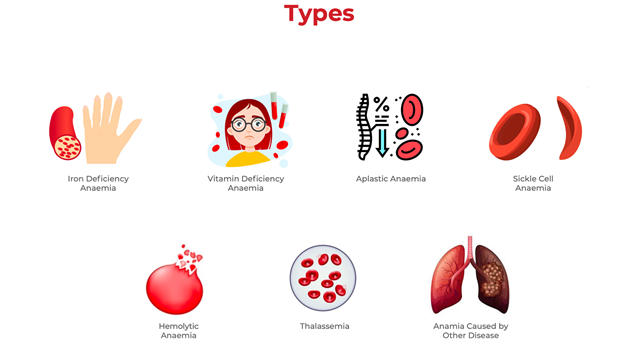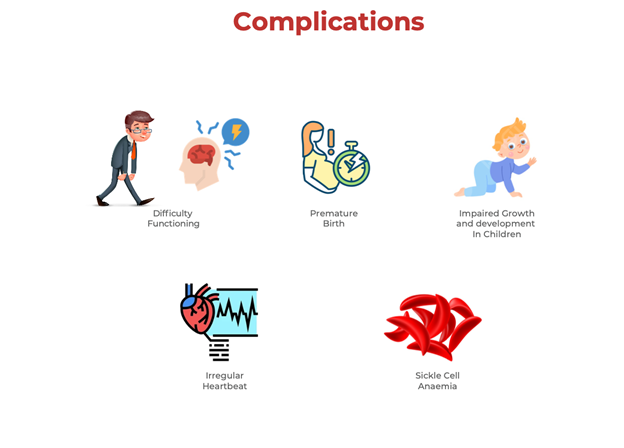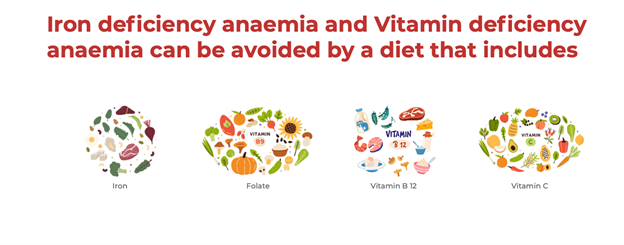Anaemia: Types, Symptoms, Diagnosis, and More
Overview
Anaemia is the most common blood disorder in which you lack enough healthy red blood cells to carry adequate oxygen to your body’s tissues. Having anaemia, also referred to as low haemoglobin, can make you feel tired and weak.
There are many forms of anaemia, each with its cause. Anaemia can be temporary or long term and can range from mild to severe. In most cases, anaemia has more than one cause.
Let us go over the common types of anaemia in the next section.

What are the common types of Anaemia?
- Iron-Deficiency Anaemia is the most common type of anaemia. Some of the causes of iron deficiency include:
- Chronic bleeding: In women, iron deficiency may be due to heavy menstrual periods or bleeding fibroids. In older women and men, the bleeding is usually from the disease of the intestines such as ulcers and cancer.
- Dietary deficiency: Children and pregnant or nursing women especially need more iron due to increased requirements. In pregnant women, lack of iron can lead to low birth weight babies and premature delivery. Newborns who are nursing from deficient mothers tend to have iron deficiency anaemia as well.
- Absorption problem: Certain conditions such as celiac disease, Crohn’s disease, intestinal surgery such as gastric bypass affect the absorption of iron from food in the gastrointestinal (GI) tract and over time can result in anaemia.
- Vitamin-deficiency anaemia may result from low levels of vitamin B12 or folate (folic acid), usually due to poor dietary intake. Pernicious anaemia is a condition in which vitamin B12 cannot be absorbed in the gastrointestinal tract.
- Aplastic Anaemia is a rare bone marrow failure disorder in which the bone marrow stops making enough blood cells. This occurs as a result of deficiency of blood-forming stem cells in the bone marrow. Viral infections, ionising radiation, and exposure to toxic chemicals can also result in aplastic anaemia.
- Sickle Cell Anaemia is an inherited hemolytic anaemia in which the haemoglobin protein is abnormal, causing the red blood cells to be rigid and clog the circulation because they are unable to flow through small blood vessels.
- Hemolytic Anaemia is a disorder in which red blood cells are destroyed prematurely, at a faster rate than they are produced by the bone marrow. Hemolytic anaemia may be due to infections, autoimmune disorders, or congenital abnormalities in the red blood cell. Inherited abnormalities may also affect the haemoglobin or the red blood cell structure or function.
- Thalassemia is an inherited blood disorder in which the body makes an abnormal form of haemoglobin. Haemoglobin is the protein molecule in red blood cells that carries oxygen. The disorder results in excessive destruction of red blood cells, which leads to anaemia.
- Anaemia caused by other diseases such as cancer, rheumatoid arthritis, kidney disease, diabetes, tuberculosis, HIV, Crohn’s disease and other acute or chronic inflammatory diseases can interfere with the production of red blood cells.

What are the symptoms of Anaemia?
The most common symptom of anaemia is fatigue. Other signs and symptoms of anaemia may include:
- Shortness of breath
- Irregular heartbeats
- Pale skin
- Chest pain
- Dizziness
- Headache
- Cold hands and feet
- Hair Loss
- Difficulties with memory and concentration

What are the risk factors for Anaemia?
You may be at increased risk of Anaemia in the following cases:
- A diet consistently low in iron, vitamin B-12 and folate
- Intestinal disorders such as Crohn’s disease and celiac disease
- Women of childbearing age are at higher risk for iron-deficiency anaemia because of blood loss during their monthly periods.
- Pregnant women are at higher risk for the condition because they need twice as much iron as usual
- Chronic diseases such as rheumatoid arthritis or other autoimmune diseases, kidney disease, diabetes, cancer, liver disease, thyroid disease, HIV
- Family history of inherited anaemia, such as sickle cell anaemia
- People who are over the age of 65 years
- People who face exposure to toxic chemicals
- People who suffer from alcoholism

What are the possible complications of Anaemia?
If untreated, anaemia can cause many health problems such as:
- Difficulty functioning in everyday life because of fatigue, shortness of breath, and difficulty concentrating
- Pregnancy complications such as premature birth.
- Impaired growth and development in children
- Anaemia can lead to a rapid or irregular heartbeat (arrhythmia). In the case of Anaemia, the heart has to pump more blood to make up for the lack of oxygen in the blood leading to an enlarged heart or heart failure.
- Some inherited anemias, such as sickle cell anaemia, can lead to life-threatening complications.

What are the tips to prevent Anaemia?
Iron deficiency anaemia and Vitamin deficiency anaemia can be avoided by a diet that includes a variety of vitamins and minerals, including:
- Iron: Iron-rich foods include meat, beans, lentils, iron-fortified cereals, dark green leafy vegetables, and dried fruit.
- Folate: It can be found in fruits and fruit juices, dark green leafy vegetables, green peas, kidney beans, peanuts, and enriched grain products, such as bread, cereal, pasta and rice.
- Vitamin B-12: Foods rich in vitamin B-12 include meat, dairy products, and fortified cereal and soy products.
- Vitamin C: Foods rich in vitamin C include citrus fruits and juices, peppers, broccoli, tomatoes, melons and strawberries. These also help increase iron absorption.

How is Anaemia diagnosed?
Several routine laboratory tests may be used to help diagnose anaemia as well as help to determine the underlying cause.













